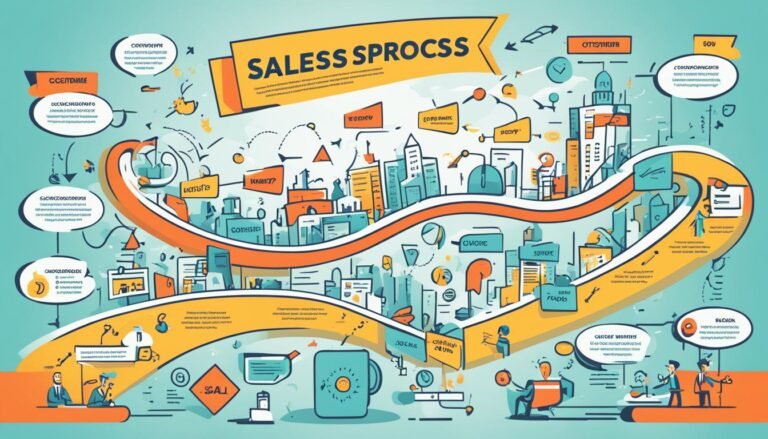Boosting Sales with Reciprocity Influence – Tips
Welcome to our article on boosting sales with the power of reciprocity influence. In the world of sales, understanding and harnessing the psychological principles of persuasion can make all the difference in closing deals and building strong customer relationships. One such principle is the Law of Reciprocity, which states that people feel obligated to reciprocate when someone does something for them first. In this article, we will explore the influence of reciprocity in sales, provide valuable sales techniques, and delve into the fascinating world of sales psychology.
Key Takeaways:
- The Law of Reciprocity is the human tendency to feel obligated to do something in return when someone does something for you first.
- Understanding and using the Law of Reciprocity can be highly beneficial in sales, as it helps build trust and influence buyers.
- Salespeople can implement reciprocity in various ways, such as offering free samples, providing personalized gestures of goodwill, and adding value throughout the sales process.
- Examples of reciprocity in sales include providing free food or drink, making valuable introductions, actively listening to prospects, and using tactics like the “reject then retreat” strategy.
- Reciprocity marketing is also prevalent in well-known brands like Amazon Prime, Dropbox, TOMS Shoes, Starbucks, and Sephora.
What Is the Law of Reciprocity?
The Law of Reciprocity, as defined by Robert Cialdini, is the human predisposition to feel obligated to reciprocate when someone does something for you first. This principle holds true in both personal and professional settings, including sales. When someone does a favor or goes out of their way to help you, you naturally feel the need to do something in return. Understanding this principle is crucial for salespeople looking to build trust and influence buyers.
Why Is the Law of Reciprocity Beneficial in Sales?
The Law of Reciprocity is a highly effective sales tactic that taps into the innate human need to reciprocate when someone does something nice for us. This principle holds true in various aspects of life, including sales interactions. By incorporating reciprocity into the sales process, salespeople can create a positive experience for their prospects and build trust. This attentiveness and value-added approach can differentiate salespeople from the competition and ultimately increase the likelihood of closing sales.
The benefits of reciprocity in sales are numerous. Let’s explore some of the key advantages:
- Establishes Trust: When salespeople go out of their way to offer something of value to their prospects, it creates a sense of trust. The prospects perceive the salesperson as genuinely caring about their needs.
- Creates a Positive Experience: Reciprocity allows salespeople to create a positive experience for their prospects. By offering personalized gestures, free samples, or unexpected favors, salespeople enhance the overall sales interaction.
- Differentiates from Competitors: Incorporating reciprocity tactics into the sales process sets salespeople apart from the competition. It demonstrates a genuine commitment to the prospect’s well-being and long-term satisfaction.
- Increases Engagement: The Law of Reciprocity encourages prospects to engage more actively in the sales process. They are more likely to provide valuable feedback, ask questions, and express their needs, leading to a more fruitful sales conversation.
- Boosts Conversion Rates: When prospects feel a sense of reciprocity, they are more likely to reciprocate by making a purchase. This increased trust and positive experience can significantly enhance conversion rates.
By leveraging the principle of reciprocity in sales, salespeople can build stronger relationships with their prospects, enhance customer loyalty, and ultimately drive business growth.
“Reciprocity is a powerful tool in sales and marketing. By understanding the Law of Reciprocity and applying it effectively, salespeople can boost their sales and build customer loyalty.”
Real-World Example: Amazon Prime
An excellent illustration of the benefits of reciprocity in sales is the success of Amazon Prime. By offering free two-day shipping, access to streaming services, and other exclusive benefits, Amazon creates a strong sense of reciprocity with its customers. This reciprocity mindset compels customers to make repeat purchases from Amazon to maximize the benefits they receive as Prime members. The reciprocity-driven loyalty created by Amazon Prime has played a significant role in driving their sales and customer retention efforts.
| Benefits | Description |
|---|---|
| Free Two-Day Shipping | Customers with Amazon Prime enjoy fast and free delivery on a wide range of eligible products. |
| Access to Streaming Services | Prime Video and Prime Music offer customers a vast library of movies, TV shows, and music to enjoy as part of their membership. |
| Exclusive Deals and Discounts | Prime members gain access to special discounts, deals, and early access to sales events. |
| Prime Reading | Members have access to a diverse collection of e-books, magazines, and audiobooks as part of their subscription. |
| Prime Day | Amazon’s annual Prime Day offers exclusive deals and discounts to Prime members, further fostering the reciprocity relationship. |
How to Use the Law of Reciprocity in Sales
Implementing reciprocity in sales strategies can significantly enhance the effectiveness of your sales process. By understanding the power of the Law of Reciprocity, you can create a positive experience for your prospects and build trust, increasing the likelihood of closing sales.
Offer Free Samples or Gifts
One effective strategy is to offer free samples or gifts to your prospects. By providing something of value upfront, you create a sense of obligation for the recipient to reciprocate by making a purchase. This can be especially impactful when the sample or gift is relevant to your product or service, allowing prospects to experience its benefits firsthand.
Provide Personalized and Unexpected Gestures of Goodwill
Another way to utilize the Law of Reciprocity is by providing personalized and unexpected gestures of goodwill. This can include making a valuable introduction for your prospect, connecting them with someone who can help them achieve their goals. Additionally, actively listening to your prospect’s needs and offering genuine assistance can go a long way in building trust and reciprocity.
Remember, reciprocity is not just about the tangible value you provide; it’s also about empathy, attentiveness, and adding value to the prospect’s experience. Look for opportunities to initiate goodwill throughout your sales interactions, consistently demonstrating your commitment to their success.
When implementing reciprocity in your sales strategy, be genuine and authentic in your efforts. Building trust and nurturing relationships should always be the primary focus. By effectively using the Law of Reciprocity, you can differentiate yourself from competitors, establish long-lasting customer relationships, and ultimately drive sales success.
Implementing reciprocity in sales strategies can enhance the effectiveness of your sales process.
The Law of Reciprocity Examples
The Law of Reciprocity in sales can be applied in various ways to foster strong relationships and drive customer engagement. Here are some powerful examples of how reciprocity can be effectively used in sales:
1. Offering Free Food or Drink
Providing complimentary refreshments during sales meetings or trade shows creates a positive experience and encourages reciprocity by making prospects feel valued.
2. Providing SWAG (Free Samples or other Freebies)
Offering free samples or promotional items not only generates excitement but also creates a sense of obligation in recipients to reciprocate by considering a purchase.
3. Making Valuable Introductions
Facilitating introductions to key contacts or industry influencers shows genuine goodwill and can trigger reciprocity from the recipient, who may be more willing to engage in business discussions.
4. Actively Listening to Prospects
Showing empathy and actively listening to prospects’ needs fosters trust and reciprocity. By demonstrating a genuine interest in understanding their challenges, salespeople can build stronger connections.
5. Exchanging Good Reviews
A mutual exchange of positive reviews or testimonials can create a reciprocal relationship based on goodwill. By supporting others’ businesses, you are likely to receive support in return.
6. Being Mindful of the Prospect’s Time
Respecting the prospect’s time and being efficient in meetings or interactions can trigger reciprocity. By valuing their time, you establish a positive perception and increase the chances of mutually beneficial outcomes.
7. Offering Free Education
Providing valuable educational resources, such as e-books, webinars, or workshops, establishes credibility and builds reciprocity with prospects who appreciate the knowledge and expertise shared.
8. Providing Peace of Mind through Warranties or Guarantees
Offering strong warranties or guarantees demonstrates confidence in your product or service and provides peace of mind to customers. This creates a sense of reciprocity as customers feel compelled to reciprocate by choosing your brand.
9. Creating Personalized Sales Collateral
Tailoring sales collateral to address the specific needs and pain points of prospects shows your commitment and dedication. This personal touch can trigger reciprocity by making prospects more likely to engage and reciprocate your effort.
10. Using the “Reject then Retreat” Tactic to Trigger Reciprocity
This technique involves initially presenting a higher-priced offer and then “retreating” to a more reasonable or favorable offer. By doing so, you leverage the principle of reciprocity, as prospects feel compelled to reciprocate the concession by accepting the revised offer.
These examples demonstrate the versatility and effectiveness of reciprocity in sales. By incorporating these strategies, sales professionals can build strong relationships, foster trust, and ultimately drive sales success.
| Reciprocity Examples in Sales | Description |
|---|---|
| Offering Free Food or Drink | Providing complimentary refreshments during sales meetings or events to create a positive experience and encourage reciprocity. |
| Providing SWAG (Free Samples or other Freebies) | Offering free samples or promotional items to generate excitement and create a sense of obligation to reciprocate through a purchase. |
| Making Valuable Introductions | Facilitating introductions to influential contacts or industry experts to trigger reciprocity and gain engagement. |
| Actively Listening to Prospects | Showcasing empathy and actively listening to prospects’ needs to build trust and foster reciprocity. |
| Exchanging Good Reviews | Mutually sharing positive reviews or testimonials to create a reciprocal relationship based on goodwill and support. |
| Being Mindful of the Prospect’s Time | Respecting the prospect’s time and being efficient in meetings to establish a positive perception and trigger reciprocity. |
| Offering Free Education | Providing valuable educational resources, such as e-books or webinars, to establish credibility and build reciprocity with prospects. |
| Providing Peace of Mind through Warranties or Guarantees | Offering strong warranties or guarantees to create a sense of reciprocity as customers feel compelled to reciprocate your brand’s commitment. |
| Creating Personalized Sales Collateral | Tailoring sales collateral to address prospects’ specific needs, demonstrating commitment, and triggering reciprocity. |
| Using the “Reject then Retreat” Tactic | Presenting a higher-priced offer and then retreating to a more favorable offer, leveraging reciprocity principles. |
Amazon Prime
Amazon Prime is an example of reciprocity marketing in action. By offering free two-day shipping, access to streaming services, and other benefits, Amazon creates a sense of reciprocity with its customers. The customers feel obligated to make future purchases from Amazon to take advantage of the benefits they receive as Prime members. This creates customer loyalty and drives sales for Amazon.
| Benefits of Amazon Prime | Explanation |
|---|---|
| Free two-day shipping | Customers enjoy fast and convenient delivery for their purchases. |
| Access to streaming services | Prime members can enjoy movies, TV shows, and exclusive content through platforms like Prime Video. |
| Exclusive discounts and deals | Prime members have access to special offers on a wide range of products. |
| Prime Reading | Members can borrow and read a vast collection of eBooks, magazines, and comics. |
| Prime Music | Subscribers can listen to millions of songs ad-free and create personalized playlists. |
The reciprocity created by Amazon Prime encourages customers to continue shopping with Amazon to make the most of their membership benefits. It has become a successful strategy for Amazon, as it not only drives sales but also fosters long-term customer loyalty.
Dropbox Referral Program
Dropbox utilizes reciprocity marketing through its referral program. By offering additional storage space rewards to both the referrer and the referred, Dropbox encourages its customers to refer new customers to the service. This creates a sense of reciprocity with its users, who are more likely to refer new customers to receive additional storage space rewards. The referral program helps grow Dropbox’s user base and increases customer loyalty.
The Dropbox referral program is a win-win situation for both the existing users and the new customers. Existing users are incentivized to spread the word about Dropbox, and in return, they receive extra storage space for their files. This not only helps Dropbox attract new customers but also boosts user engagement and promotes customer loyalty.
The referral program works by providing users with a unique referral link that they can share with their friends, family, or colleagues. When someone signs up using their referral link and becomes a paying customer, both the referrer and the referred individual receive additional storage space as a reward. This incentive encourages users to actively promote Dropbox and recommend it to others.
By leveraging reciprocity marketing, Dropbox taps into the psychological principle of reciprocity. When someone receives a benefit or favor, they feel obliged to reciprocate in some way. In the case of the referral program, existing users feel motivated to refer others to Dropbox to receive the extra storage space reward.
This referral program has been highly successful for Dropbox, contributing to its rapid growth and user acquisition. By offering a valuable reward and leveraging the power of reciprocity, Dropbox has effectively turned its existing user base into brand ambassadors and advocates.
TOMS Shoes “One for One”
TOMS Shoes’ “One for One” program is an example of reciprocity marketing in the retail industry. For every pair of shoes purchased, TOMS donates a pair of shoes to a child in need. This creates a sense of reciprocity with customers, who feel good about their purchase knowing they are also helping someone in need. This program enhances brand loyalty and drives sales for TOMS Shoes.
The “One for One” program sets TOMS Shoes apart from other footwear brands. With every purchase, customers contribute to a meaningful cause, making them feel like they are making a positive impact on the world. By aligning their business model with charitable giving, TOMS Shoes taps into the human desire to reciprocate and fosters a strong bond between the brand and its customers.
Customers who buy TOMS Shoes not only receive a high-quality product but also become part of a movement to provide shoes to children who lack access to proper footwear. This emotional connection and the feeling of doing good contribute to increased customer loyalty and word-of-mouth marketing. Through the “One for One” program, TOMS Shoes has built a loyal community of customers who actively support and advocate for the brand.
Reciprocity marketing, as exemplified by TOMS Shoes, is a powerful way to engage customers and differentiate a brand in a competitive market. By leveraging the innate human inclination to reciprocate acts of kindness, businesses can establish a deep connection with their customers and drive sales while making a positive social impact.
Starbucks Loyalty Program
Starbucks’ loyalty program is a prime example of reciprocity marketing. By rewarding customers with free drinks and food items for repeat purchases, Starbucks creates a sense of reciprocity with its customers. This feeling of being rewarded for their loyalty encourages customers to continue purchasing from Starbucks, leading to increased customer retention and sales.
Starbucks also utilizes other reciprocity strategies such as charitable initiatives and personalized customer experiences. Through initiatives like the Starbucks Foundation, which supports education, community development, and environmental stewardship, Starbucks fosters a sense of reciprocity with its customers by giving back to the community. This not only enhances customers’ perception of the brand but also creates a deeper connection and loyalty.
Additionally, Starbucks provides personalized customer experiences through its mobile app and rewards program. Customers receive personalized offers, birthday rewards, and early access to new products. This level of personalization makes customers feel valued and appreciated, further strengthening the reciprocity relationship between Starbucks and its loyal patrons.
Starbucks Loyalty Program Benefits:
- Free drinks and food items for repeat purchases
- Charitable initiatives that give back to the community
- Personalized customer experiences through the mobile app and rewards program
By implementing a comprehensive reciprocity program, Starbucks successfully leverages reciprocity marketing to foster customer loyalty, increase sales, and create a positive brand image.

Sephora Beauty Insider
Sephora’s Beauty Insider program exemplifies the power of reciprocity marketing in the beauty industry. By offering various rewards and perks to its members, Sephora creates a strong sense of reciprocity with its customers. Not only do they feel valued and appreciated, but they are also motivated to continue their loyalty and engagement with the brand.
The Beauty Insider program is designed to reward customers based on their loyalty and purchases. Members can accumulate points with every purchase and redeem them for exclusive products, deluxe samples, and even VIP experiences. The more customers engage with Sephora, the more they are rewarded, reinforcing the reciprocal relationship between the brand and its customers.
Furthermore, Sephora goes beyond just rewards by focusing on personalized customer experiences. The brand provides beauty consultations, product recommendations, and educational resources to help customers make informed decisions and enhance their beauty routines. This personalized approach not only adds value to the customer’s experience but also deepens the reciprocity between Sephora and its customers.
Another aspect that strengthens the reciprocity marketing in Sephora’s strategy is their generous return policy. Sephora allows customers to return products, even after usage, within a specific timeframe. This commitment to customer satisfaction instills confidence and trust, further solidifying the bond between the brand and its customers.
Ultimately, Sephora’s Beauty Insider program leverages reciprocity marketing to its advantage. By offering rewards, personalized experiences, and a generous return policy, Sephora nurtures a strong and loyal customer base. This reciprocity-driven relationship drives sales for the brand and establishes Sephora as a leader in the beauty industry.
| Rewards and Perks | Benefits |
|---|---|
| Exclusive products | Achieve a sense of exclusivity and access limited edition items |
| Deluxe samples | Try new and popular products without extra cost |
| VIP experiences | Get the opportunity to attend exclusive events and access special beauty services |
| Points accumulation | Earn points with each purchase and redeem them for rewards |
| Beauty consultations | Receive personalized advice and recommendations from beauty experts |
| Educational resources | Access tutorials, product guides, and other helpful content |
Tips for Using Reciprocity Marketing in Your Business
If you want to incorporate reciprocity marketing into your business, consider the following tips:
- Offer something of value first to create a sense of obligation in your customers. Whether it’s a free sample, exclusive content, or a personalized gift, providing something valuable upfront sets the stage for reciprocity.
- Make your customers feel special and appreciated. Take the time to engage with your customers on a personal level, remembering their preferences and celebrating milestones. This personal touch strengthens the emotional connection and fosters a reciprocal relationship.
- Provide value outside of your store by offering free resources or helpful content. Share industry insights, practical tips, or expert knowledge that can benefit your customers. By positioning yourself as a valuable resource, you enhance reciprocity by providing ongoing value beyond the transaction.
- Make the experience memorable to leave a lasting impression on customers. Surprise and delight them with unexpected gestures, exceptional customer service, or unique packaging. By going above and beyond, you create a positive and memorable experience that fuels reciprocity.
- Keep the relationship going by engaging customers with additional rewards or personalized experiences. Offer loyalty programs, exclusive discounts, or VIP perks that make customers feel appreciated and part of a community. Continually nurturing the customer relationship encourages reciprocity and strengthens brand loyalty.
Implementing reciprocity strategies can have a powerful impact on your business. By understanding the psychology behind reciprocity and applying these tips, you can leverage the principle to build strong relationships with your customers, increase customer loyalty, and drive sales.
| Benefits of Reciprocity Marketing | Implementing Reciprocity Strategies |
|---|---|
| Builds trust and credibility | Offer something of value first |
| Enhances brand loyalty | Make customers feel special and appreciated |
| Increases customer retention | Provide value outside of your store |
| Drives sales and revenue | Make the experience memorable |
| Cultivates a community of loyal customers | Keep the relationship going |
Conclusion
Reciprocity is a powerful tool in sales and marketing. By understanding and applying the Law of Reciprocity effectively, salespeople can boost their sales and build customer loyalty. The Law of Reciprocity, as defined by Robert Cialdini, taps into the human tendency to feel obligated to reciprocate when someone does something nice for us.
Incorporating reciprocity marketing strategies, as seen in examples like Amazon Prime, Dropbox, TOMS Shoes, Starbucks, and Sephora, can further enhance the effectiveness of the Law of Reciprocity. These brands offer something of value first to create a sense of obligation in their customers. They make customers feel special and appreciated, provide value beyond the purchase, create memorable experiences, and continue to engage customers to strengthen the reciprocity relationship.
To successfully implement reciprocity marketing, salespeople and businesses should remember to offer something of value first, make their customers feel special, provide value outside of their stores, create memorable experiences, and continue to engage customers. Understanding the power of reciprocity and utilizing it in sales and marketing strategies can lead to increased sales and customer loyalty.







